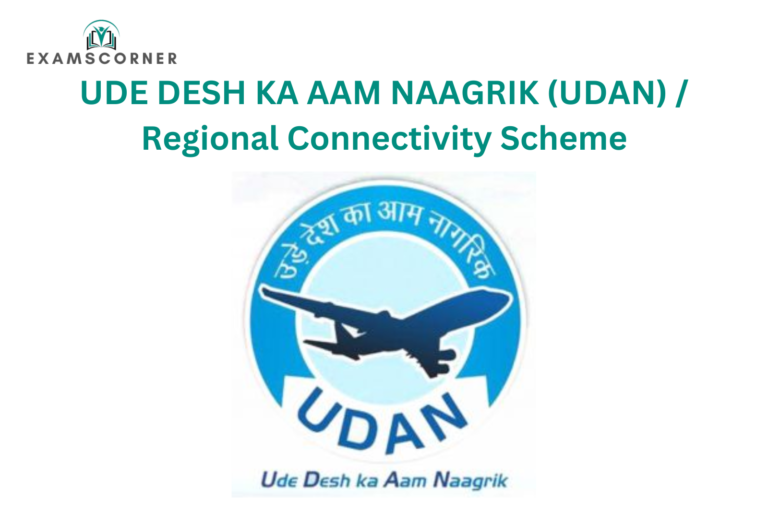The UDE DESH KA AAM NAAGRIK (UDAN), also known as the Regional Connectivity Scheme (RCS), has been a significant initiative under the National Civil Aviation Policy (NCAP) 2016. Launched with the vision of enhancing regional air connectivity, UDAN seeks to make air travel accessible to a larger section of the population, including residents of Tier II and Tier III cities.
This scheme aims to bridge the gap between underserved and unserved routes, promoting balanced regional growth and making flying affordable.

In recent news, the Comptroller and Auditor General’s (CAG) Audit Report on the UDAN scheme was laid down in both houses of the Parliament, further highlighting its progress and impact.
Purpose and Objectives
The main objective of the UDAN scheme is to enable air operations on underserved and unserved routes, ensuring that people in remote regions have access to air connectivity. By improving regional air connectivity, the scheme helps in promoting the balanced growth of both urban and rural areas. It also aims to make air travel affordable, with airfare capped at Rs. 2500 for distances between 500 km to 600 km per seat.
The overall purpose includes:
- Enhancing Aviation Infrastructure: To improve air connectivity in Tier II and Tier III cities.
- Promoting Balanced Regional Growth: Boosting the regional economy by making it easier for people to travel within the country.
- Affordable Air Travel: Making air travel affordable for the common man, which was once considered a luxury.
Key Features of UDAN / RCS
Here’s a look at some of the critical features of the UDAN scheme:
1. Launched Under the National Civil Aviation Policy (NCAP) 2016:
The Regional Connectivity Scheme (RCS) was launched as a part of the National Civil Aviation Policy (NCAP) 2016 with a clear vision to improve regional connectivity and facilitate economic development.
2. Subsidized Airfares:
One of the most attractive features of UDAN is the subsidized airfare. The airfare for a distance between 500 km to 600 km is capped at Rs. 2500 per seat, ensuring that air travel remains affordable for a broader section of the population. However, this capping is subject to indexation based on the formula mentioned in the UDAN Scheme document.
3. Airline Participation and Subsidized Seats:
Airlines participating in the scheme are required to provide 50% of the seats (ranging from 9-40 seats) at subsidized rates, making it easier for people from Tier II and Tier III cities to access affordable air travel.
4. Regional Connectivity Fund (RCF):
The Regional Connectivity Fund (RCF) plays a vital role in the success of the UDAN scheme. It ensures the self-financing mechanism of the scheme by funding the Viability Gap Funding (VGF). The VGF is funded through a levy on certain domestic flights, further ensuring the smooth implementation of the scheme.
5. Support to Airlines:
To encourage airlines to operate on regional routes, the government offers significant financial support. The Centre shares 80% of the VGF, while the remaining 20% is contributed by the respective state governments. Special provisions have been made for Northeastern states, Uttarakhand, Himachal Pradesh, and Union Territories, where the state government contributes only 10%.
6. Flexibility in Identifying Routes:
The UDAN scheme offers flexibility in identifying regional routes. Airlines interested in operating on underserved or unserved routes can propose them and seek financial support under the VGF. This ensures that the most demanded routes are prioritized for connectivity.
7. State Government Contribution:
State governments play a crucial role in the success of the scheme by providing essential services at concessional rates. These include:
- Free security and fire services
- Utilities at concessional rates
- Free land for building RCS airports
This collaborative approach ensures the development of infrastructure required to support the growth of regional air travel.
UDAN’s Long-Term Vision
The UDAN scheme is a 10-year central sector scheme, which aims to reshape the air connectivity landscape in India by reaching out to underserved and unserved regions. Over time, the scheme is expected to fulfill the aspirations of millions of common citizens, providing them with affordable and accessible air travel options.
Conclusion
The UDE DESH KA AAM NAAGRIK (UDAN) / Regional Connectivity Scheme (RCS) is a groundbreaking initiative that promises to change the face of air travel in India. By connecting smaller towns and cities to major airports, promoting balanced regional growth, and offering affordable airfares, UDAN aims to make air travel a reality for the common man. With its support to airlines, government assistance, and the flexibility to identify routes, UDAN is all set to revolutionize India’s aviation sector and bring the country closer together.
This scheme reflects the government’s commitment to improving the aviation infrastructure in India and ensuring that flying becomes a reality for every citizen, no matter where they live.



